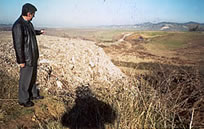Participant Training / Human and Institutional Capacity Development
 |
| Mr. Hysin Shamata of Kavaja, Albania points out a garbage mound that will
soon be covered in grass to maintain an attractive countryside view.
This technique for solid waste management is just one approach learned
as a result of a recent third-country training program undertaken in
Hungary. For more information on this key activity click on the Albanian
Success Story entitled “Training
Leads to Solid Success in Cleaning Up Albanian Cities.” |
Training/human capacity development is a key component of most USAID activities. Without it USAID projects have limited impact and sustainability.
Each year, USAID supports the training of hundreds of thousands of host country individuals. Programs are mostly short-term (technical training, study visits, leadership development, public diplomacy) but also some long-term (academic degree studies, non-degree research or leadership programs) held in the United States, the home country, or a third country. In 2007, the number of training participants was over 478,000, including 4,480 in U.S. programs. Participants are drawn from the public or private sector and may be mid- and high-level managers, local leaders, teachers and education administrators, technicians, and NGO staff. All training helps individuals acquire new skills, knowledge, and attitudes critical to the achievement of Mission goals.
Participants typically are drawn from organizations with which the USAID Mission is partnered in a development project. In these situations, training may be one element of a coordinated human and institutional capacity development program that focuses not on the transfer of skills and knowledge and improved job performance of the individual but on increased output or productivity in the partner organization. To this end, training to address skill and knowledge gaps is just one tool, along with interventions to deal with other performance barriers, such as dysfunctional organizational structure, unsupportive work atmosphere, or lack of necessary tools and incentives. Success of training and other capacity development interventions is measured by improvement in overall organizational performance and output, not the number of individuals trained.
“In addition to being implemented under many individual technical projects in all sectors, USAID participant training and capacity development is also managed under a worldwide contract, FORECAST (Focus on Results: Enhancing Capacity across Sectors in Trainsition Countries) by two contractors. For details, see the websites of the Academy for Educational Development (AED) and World Learning (click on Projects.)”
Training policies and procedures are found in USAID’s Automated Directive System (ADS), ADS Chapter 253 Training for Development. Bringing participants to the United States involves additional planning and procedural steps with regard to acquiring the J-1 visa, required of all training and exchange visitors. See also:
Back to Top ^ |


